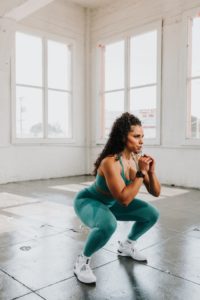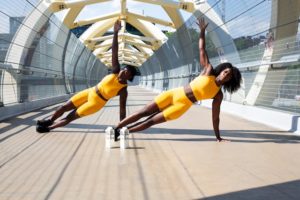Are you feeling like your love handles got out of control, you are demotivated and feel overweight?
Do you happen to complain of back pain or pins and needles down your leg?
 If your answer is yes for both questions, research shows clearly that it is time to correlate the risk of herniated discs and spinal pressure to obesity and the bad posture and muscle imbalance associated with it.
If your answer is yes for both questions, research shows clearly that it is time to correlate the risk of herniated discs and spinal pressure to obesity and the bad posture and muscle imbalance associated with it.
In fact, research shows that the relation between herniated discs and obesity is straight forward, but it is usually overlooked by most of the personal trainers in London, UK and around the world.
However, if you understand the relation between being overweight and herniated discs, you will also understand why an expert rehab personal trainer who is specialised in back health rehab transformations is totally different from the norm.
And why this type of a professional personal trainer is:
– Required to see your herniated disc diagnosis
– Completing comprehensive technical assessments on your case
– Focusing on modifying the risk factors
– Creating the best customised diet plan for your goals
– Changing the type and quality of the food you eat and the outcome you will create.
– Planning your exercises carefully to target weight loss without flaring your back pain
By the way,
If you would like to learn why my clients describe this unique back rehab transformation methodology as the most successful, predictable and comprehensive back transformation programme in the UK here are just a few case studies like Hayley, Franco, Elizabeth Tiffany, Jan, Michaela, W.T. Police officer, Emma, Huw or Dr Christian NHS.
Obesity-Related Risk Factors for Herniated Discs
Believe it or not, back pain was considered the leading cause of disability all over the world and research shows that London is not an exception. [1]
Moreover, herniated discs are considered the most common cause of chronic low back pain.
Meanwhile, UK Parliament library statistics show that in London and the UK, 25.9% of adults were found to be obese and out of this percentage 37.9% of them are overweight. [2]
You may think these are two different problems.
But in fact, research shows that they are more related than you think.
According to scientific research, obesity is directly associated with increased risk of:
– Heart disease (e.g., angina and heart attack)
– Vascular disease (e.g., atherosclerosis and Deep venous thrombosis)
– Diabetes and insulin resistance
– Joint disease (e.g., arthritis)
– Prostate disorders [3],[4]
On the first sight, you can relate why obesity leads to all these diseases and problems.
But, did you also know that research shows that the higher the BMI, the more the risk for:
– spinal diseases (e.g., spinal stenosis)
– Low back pain,
– Spondylosis and disc degeneration
– intervertebral disc disorder (e.g., disc herniation) [3],[5],[6]
How does that happen?
There are many reasons why obesity interferes with your spine disc health.
Here is how:
More pressure
Think of your discs as cushions that are present between your vertebrae.
They work hard to absorb the weight falling on them and they function to allow you to move around and have a flexible spine.
But, what if you overload them?
Each spinal segment carries the weight of the body parts above.
For instance, the cervical spine (the neck) carries the weight of the head while the lumbar spine (the back) carries the weight of the head, torso and arms.
Thus, there was no evidence that increased BMI is related to cervical disc problems, because research confirms that excess fats do not make the head any heavier. [7]
But at the same time, there was a close relation between carrying extra weight and lumbar disc herniations.
That’s it!
Increased pressure on the spine puts more load on the discs causing them to fail, bulge or herniate out of their normal place. [7]
Poor Spinal Alignment
Obesity leads to abnormal weight distribution around different body parts.
For example, if you carry more weight around the belly, your spine will be pulled more towards lordosis (curving inwards), your pelvis will be tilted forward which leads to poor posture and alignment
Specially at the level of your lumbar and sacral vertebrae. Subsequently, this abnormal alignment leads to accelerated spinal degeneration
As a result of the uneven weight falling on the discs and the Reduced flexibility and mobility. [8]
Muscle Imbalance
London’s fast paced lifestyle does not always allow for most of us to exercise and remain active.
From relying on fast food and unhealthy snacking to spending hours working on a desk.
All these factors and more lead to muscle imbalance and subsequent postural misalignments.
If you slouch on a desk, your chest and thigh muscles tighten up, your abs, glutes and back muscles become weak.
Research shows that…
This imbalance between muscle lengths and strengths leads to abnormal posture, affects your spine stability and puts severe extra stress on your vertebral discs. [9],[10]
Low-Grade Inflammation
Obesity leads to low-grade chronic inflammation because it is associated with high levels of Leptin and resistin, which are pro-inflammatory hormones and this is only the tip of the iceberg.
- Did you know that research show that the state of active inflammation in the body leads to increased risk of disc degeneration and cartilage inflammation? [11]
Now that you know more about how obesity and herniated disc are related, it is time to find out how research shows that how customising the way you eat helps not only managing your weight, but to some extent also preventing disc herniation [11],[12],[13]
The Role of Customised Nutrition in Herniated Disc Prevention
A professional customised nutrition plan can help you keep a healthy spine and to some extent prevent disc degeneration and disc herniations.
You can be the fittest, healthiest in London if you watch the food you consume.
Here is how nutrition can change your life – and spine health:
1- Get in shape
 Following a personalised diet plan will help Maintaining a healthy body weight and lose the extra pounds that are burdening your spine.
Following a personalised diet plan will help Maintaining a healthy body weight and lose the extra pounds that are burdening your spine.
Ready to take action?
Get rid of the extra weight and learn how to replace your fat tissue with more muscle mass by talking to Jazz Alessi, London’s number one personal trainer and London’s expert in body transformation.
Request a FREE CONSULTATION NOW!
2- Decreased inflammation
Consuming nutrient-dense foods and avoiding processed and inflammatory foods can be your shortest way to decrease the inflammatory reactions in your body and help you maintain healthy cells and proper body function.
To achieve this, make sure you consume whole plant foods like veggies, fruit and whole grains and foods rich in Omega 3 such as flax seeds and walnuts while avoiding sugar, fried and processed foods. [14]
3- Build Muscles
Consuming the right number of calories, complex carbs, the proper portions of proteins, including vitamins in your diet and staying hydrated will help you build muscle mass and prevent muscle loss.
Research shows that this way you can protect your spine by making sure your muscles will keep your body in the right posture and will provide the spine support you need. [15]
Nutritional Strategies to Support Spinal Health
Have you ever heard of microbiome?
The human microbiome are very small organisms that inhabit particular parts of our bodies; such as the gut, the respiratory tract and the skin.
This microbiota can play an important part of your health, and disc health is not an exception. [16]
In fact, what you eat can change the nature of these microbiota and lead to chronic inflammation and cell damage. [17]
So, if you want to protect your body and discs, here are some tips on what to eat:
1- Avoid processed food
Animal proteins, processed meat and fast food are all types of food you want to avoid. These foods can get the inflammation kicking in, lead to weight gain and provide more calories that your body needs. [17]
Make sure you focus on the right energy sources such as:
– Healthy proteins (e.g., chickpeas, tofu, soy beans, lentils)
– Whole grains like buckwheat, millet or quinoa
– Omega-3 fatty acids for inflammation reduction such as walnuts, coconut oil and olive oil.
– Fresh fruit and veggies that contain fibres, these will help you remain full and will provide adequate vitamins. [18]
– Plant-based dishes that will help you lose weight and provide the sufficient energy for you to build muscles and maintain healthy spine. [17],[18]
2- Vitamins and Minerals
Your body tissues are naturally and thoroughly renewed due to a normal every-day wear and tear process.
On top of this process being 100% normal, our bodies also need to repair tissues after stress.
Stress can be a simple flu, overuse or a major surgery.
In order for your body to repair, you need to provide fuel and raw material, basically through your diet.
Vitamins like vitamin C, different types of Vitamin B, vitamin K and adequate calcium and vitamin D intake in addition to minerals like Magnesium and potassium for muscle support and copper, zinc and boron for bone and connective tissues health. [19],[20]
Ready to get started?
If you would like professional to help you transform your body and restore your spine health, it is time to talk to Jazz Alessi.
Jazz is London’s number one elite rehab personal trainer and Harley Street nutrition expert.
REQUEST A FREE CONSULTATION NOW!
3- Cleansing foods
Why make yourself in need for anti-inflammatory drugs while you can prevent inflammation by consuming anti-inflammatory foods.
Believe it or not, research show that herbs, fruits, and vegetables contain natural sources of anti-inflammatory and anti-oxidant properties that you need to heal your tissues. [19,20]
Make sure you include plant-based antioxidant-rich foods to combat oxidative stress and decrease pro-inflammatory substances in your body. [20]
Let me put this simply: Always look for flavonoid in the food you consume!
Flavonoids are plants that are known to boost the healing process by knitting collagen fibers into a tightly woven tissue.
Giving you a well-knitted skin and blood vessels; dense bones, strong, elastic ligaments and tendons and of course stronger intervertebral discs.
Implementing Lifestyle Changes for Herniated Disc Prevention
 Even though changing your diet is necessary, it is not enough.
Even though changing your diet is necessary, it is not enough.
Imagine eating well while carrying out an unhealthy lifestyle that puts all your diet plans in vain.
If you are looking for a healthy body and effective pain management,
Make sure you implement the healthy habits and adopt a healthy lifestyle in all aspects of your life. [21]
Here is how to easily do that:
1- Exercise Less / Exercise Smarter
You probably expected me to say exercise more and spend at least 2 hours at the gym
But this is not right.
When you are after a complete change and you need to introduce regular physical activity to your routine, less but customised (customised exercises is the keyword here) is always more.
I mean, if you dedicate only 30 minutes 5 days a week or dedicate 20 minutes everyday to do a short set of HIIT exercises, a walk in the park or go jogging around your block, this will be way easier for you to fit in your London busy schedule and will help you bring consistence. [22].
But, will this be enough?
If you do the right type of exercise and give it some time, it will definitely work.
What type of exercises you must do when you have a herniated disc and suffer from sciatica or lower back pain?
Find out the type of exercise that will help you achieve your spine health goals faster by talking to Jazz Alessi, the best personal trainer in London.
REQUEST A FREE CONSULTATION NOW!
2- Sit/Stand Tall
Proper ergonomics at work and home is a very important part of your journey towards a healthy spine.
Because you might spend too much time working behind your computer, make your desk safer for your disc.
Change your chair, use a lumbar support pillow, sit tall, roll your shoulders back and tuck your chin in and make sure you are not idle for long while at work.
This way research shows that you will strengthen your core muscles, improve your posture and boost your spine stability [23]
If you remind yourself of doing this every day, you will see the power of good habits!
3- Chillax
Relaxing, getting sufficient sleep, getting rid of tension and using stress reduction techniques (meditation, deep breathing, Pilates, costumised Yoga) can help you maintain your spine healthy by improving your muscle condition, preventing muscle tightness and its subsequent muscle imbalances.
Conclusion
To wrap up, always remember your body and health is the best destination to invest your time and money.
And every person is unique.
Which means there is no one-fits-all diet and exercise programme that can solve all disc herniation problems.
In fact, even though two people might be diagnosed with disc herniation, the severity, mechanism and direction of herniation can be completely different.
Even if the symptoms were similar!
- For example, a person may have a lumbar disc herniation due to muscle imbalance across the pelvis leading to increased lumbar lordosis and tight back muscles.
- While another person may complain of the same symptoms because of a slipped vertebra and broken pars interarticularis (a very thin bone connecting your vertebrae together)
These two different cases of the “same diagnosis” will require completely different and laser-sharp customised rehab programmes for disc herniation.
Not to mention the body composition, that will also determine the diet plan for disc herniation
You can also get your very own comprehensive and customised plan when you talk to Jazz Alessi.
Jazz will put time and effort on listening to you, reviewing your clinician’s reports and carefully planning your rehab plan.
REQUEST A FREE CONSULTATION NOW!
Who is Jazz Alessi?
Jazz is an expert rehab personal trainer in London who prioritises your back health and safety.
He pays attention to all your details in order to create a very effective, comprehensive, easily-followed rehabilitation programme composed of the bespoke back rehab exercises and nutrition.
He takes into consideration your diagnosis, medical conditions and previous injuries to make sure the rehabilitation is safe and effective.
He does not set the rehabilitation goals, but aims at achieving your own best goals in the shortest and safest way possible while breaking them down into doable, easily noticeable milestones.
FAQs
1. Can losing weight help with herniated discs?
Losing weight is considered an essential part of disc herniation rehab. However, it must be lost in a healthy way that includes proper nutrition and exercise to make sure you are not losing muscles and impacting your spine stability.
2. What foods should I avoid if I have a herniated disc?
Avoid foods that are high in calories to maintain a healthy body weight, and also avoid pro-inflammatory foods that will make the inflammation kick in your body (e.g., processed and fried foods)
3. How can I prevent herniated discs if I am overweight?
In addition to losing the extra pounds, in a customised manner – work on your core muscles to enhance your spine stability. Also make sure you stretch regularly to restore joint and tissue mobility and flexibility.
4. Can diet and exercise help with herniated disc pain?
Customised diet and back injury exercise rehab can be considered the most effective and the safest combination to address your herniated disc pain. Just make sure you are following a healthy balanced diet and doing only the rehab exercises that are safe for your case.
5. What is the best way to lose weight for someone with a herniated disc?
The most effective and safest way to lose weight is by combining a healthy, balanced diet, smart and healthy caloric restriction with gentle aerobic exercises for at least 30 minutes, 3 days a week.
REFERENCES
1- Wilson Zingg R., Kendall R. Obesity, Vascular Disease, and Lumbar Disk Degeneration: Associations of Comorbidities in Low Back Pain. PM&R. 2016 doi: 10.1016/j.pmrj.2016.09.011.
https://pubmed.ncbi.nlm.nih.gov/27721006/
2- Adult obesity in England
https://commonslibrary.parliament.uk/research-briefings/sn03336/#:~:text=Adult%20obesity%20in%20England,is%20classified%20as%20’overweight’.
3- Sheng B, Feng C, Zhang D, Spitler H, Shi L. Associations between Obesity and Spinal Diseases: A Medical Expenditure Panel Study Analysis. Int J Environ Res Public Health. 2017 Feb 13;14(2):183. doi: 10.3390/ijerph14020183. PMID: 28208824; PMCID: PMC5334737.
https://www.ncbi.nlm.nih.gov/pmc/articles/PMC5334737/#B14-ijerph-14-00183
4- Afridi, Aien & Safdar, Mahpara & Khattak, Muhammad Muzaffar Ali Khan & Alam, Khan. (2003). Health Risks of Overweight and Obesity – An Over View. Pakistan Journal of Nutrition. 2. 10.3923/pjn.2003.350.360.
https://www.researchgate.net/publication/26563347_Health_Risks_of_Overweight_and_Obesity_-_An_Over_View
5- Sato S., Yagi M., Machida M., Yasuda A., Konomi T., Miyake A., Fujiyoshi K., Kaneko S., Takemitsu M., Machida M., et al. Reoperation rate and risk factors of elective spinal surgery for degenerative spondylolisthesis: Minimum 5-year follow-up. Spine J. 2015;15:1536–1544. doi: 10.1016/j.spinee.2015.02.009.
https://pubmed.ncbi.nlm.nih.gov/25681581/
6- Singh S., Kumar D., Kumar S. Risk factors in cervical spondylosis. J. Clin. Orthop. Trauma. 2014;5:221–226. doi: 10.1016/j.jcot.2014.07.007
https://pubmed.ncbi.nlm.nih.gov/25983502/
7- Wang Y., Wang L., Du C., Mo Z., Fan Y. A comparative study on dynamic stiffness in redtypical finite element model and multi-body model of redC6-C7 cervical spine segment. Int. J. Numer. Methods Biomed. Eng. 2016 doi: 10.1002/cnm.2750.
https://pubmed.ncbi.nlm.nih.gov/26466546/
8- Luca Vismara, Francesco Menegoni, Fabio Zaina, Manuela Galli, Stefano Negrini & Paolo Capodaglio: Effect of obesity and low back pain on spinal mobility: a cross sectional study in women
https://jneuroengrehab.biomedcentral.com/articles/10.1186/1743-0003-7-3
9- Jennifer L. Miles-Chan* and Abdul G. Dulloo: Posture Allocation Revisited: Breaking the Sedentary Threshold of Energy Expenditure for Obesity Management https://www.frontiersin.org/articles/10.3389/fphys.2017.00420/full
10- Tomlinson DJ, Erskine RM, Morse CI, Winwood K, Onambélé-Pearson G. The impact of obesity on skeletal muscle strength and structure through adolescence to old age. Biogerontology. 2016 Jun;17(3):467-83. doi: 10.1007/s10522-015-9626-4. Epub 2015 Dec 14. PMID: 26667010; PMCID: PMC4889641.
https://www.frontiersin.org/articles/10.3389/fphys.2017.00420/full
11- Ellulu MS, Patimah I, Khaza’ai H, Rahmat A, Abed Y. Obesity and inflammation: the linking mechanism and the complications. Arch Med Sci. 2017 Jun;13(4):851-863. doi: 10.5114/aoms.2016.58928. Epub 2016 Mar 31. PMID: 28721154; PMCID: PMC5507106.
https://www.ncbi.nlm.nih.gov/pmc/articles/PMC5507106/
12- Wentian, Li & Lai, Kaitao & Chopra, Neha & Zheng, Zhaomin & Das, Abhirup & Diwan, Ashish. (2022). Gut-disc axis: A cause of intervertebral disc degeneration and low back pain?. European Spine Journal. 31. 10.1007/s00586-022-07152-8. https://www.researchgate.net/publication/359220430_Gut-disc_axis_A_cause_of_intervertebral_disc_degeneration_and_low_back_pain
13- Cunha, C., Silva, A.J., Pereira, P. et al. The inflammatory response in the regression of lumbar disc herniation. Arthritis Res Ther 20, 251 (2018). https://doi.org/10.1186/s13075-018-1743-4
14- the Ohio-state university – Anti inflammatory diet
https://wexnermedical.osu.edu/-/media/files/wexnermedical/patient-care/healthcare-services/nutrition-services/nutrition-and-education/anti-inflammatory-diet.pdf
15- Aragon, A.A., Schoenfeld, B.J., Wildman, R. et al. International society of sports nutrition position stand: diets and body composition. J Int Soc Sports Nutr 14, 16 (2017). doi:10.1186/s12970-017-0174-y
https://www.frieslandcampinainstitute.com/article/international-society-of-sports-nutritions-position-statement-on-protein-and-exercise/
16- Rajasekaran S, Soundararajan DCR, Tangavel C, Muthurajan R, Sri Vijay Anand KS, Matchado MS, Nayagam SM, Shetty AP, Kanna RM, Dharmalingam K. Human intervertebral discs harbour a unique microbiome and dysbiosis determines health and disease. Eur Spine J. 2020 Jul;29(7):1621-1640. doi: 10.1007/s00586-020-06446-z. Epub 2020 May 14. PMID: 32409889. https://pubmed.ncbi.nlm.nih.gov/32409889/
17- Galland, Leo. (2010). Diet and Inflammation. Nutrition in clinical practice : official publication of the American Society for Parenteral and Enteral Nutrition. 25. 634-40. 10.1177/0884533610385703. https://www.researchgate.net/publication/49665445_Diet_and_Inflammation
18- Chronic inflammation and Diet – Beaumount health
https://www.beaumont.org/docs/default-source/pain-management/chronic-inflammation-and-diet.pdf?sfvrsn=2
19- Sedighi, M., Haghnegahdar, A. Role of vitamin D3 in Treatment of Lumbar Disc Herniation—Pain and Sensory Aspects: Study Protocol for a Randomized Controlled Trial. Trials 15, 373 (2014). https://doi.org/10.1186/1745-6215-15-373. https://trialsjournal.biomedcentral.com/articles/10.1186/1745-6215-15-373#citeas
20- Orthopod: Patient’s guide to: Nutrition and Your Spine
https://www.concordortho.com/patient-resources/patient-education/topic/083527991f897cb9e6d9d5fc4789c67b
21- El-Masri, Dana & Kreydieh, Dima & Tannir, Hana & Itani, Leila & El Ghoch, Marwan. (2018). Long-Term Weight-Loss Lifestyle Modification Programme in a Patient with Severe Lumbar Intervertebral Disc Degeneration and Obesity: A Case Report. Reports. 1. 21. 10.3390/reports1030021. https://www.researchgate.net/publication/328751982_Long-Term_Weight-Loss_Lifestyle_Modification_Programme_in_a_Patient_with_Severe_Lumbar_Intervertebral_Disc_Degeneration_and_Obesity_A_Case_Report
22- Cox CE. Role of Physical Activity for Weight Loss and Weight Maintenance. Diabetes Spectr. 2017 Aug;30(3):157-160. doi: 10.2337/ds17-0013. PMID: 28848307; PMCID: PMC5556592. https://www.ncbi.nlm.nih.gov/pmc/articles/PMC5556592/
23- Sipko, Tomasz & Supinska, Marzena & Kuczyński, Michał. (2009). Postural control in patients with lumbar disc herniation in the early postoperative period. European spine journal : official publication of the European Spine Society, the European Spinal Deformity Society, and the European Section of the Cervical Spine Research Society. 19. 409-14. 10.1007/s00586-009-1082-x. https://www.researchgate.net/publication/26326448_Postural_control_in_patients_with_lumbar_disc_herniation_in_the_early_postoperative_period



